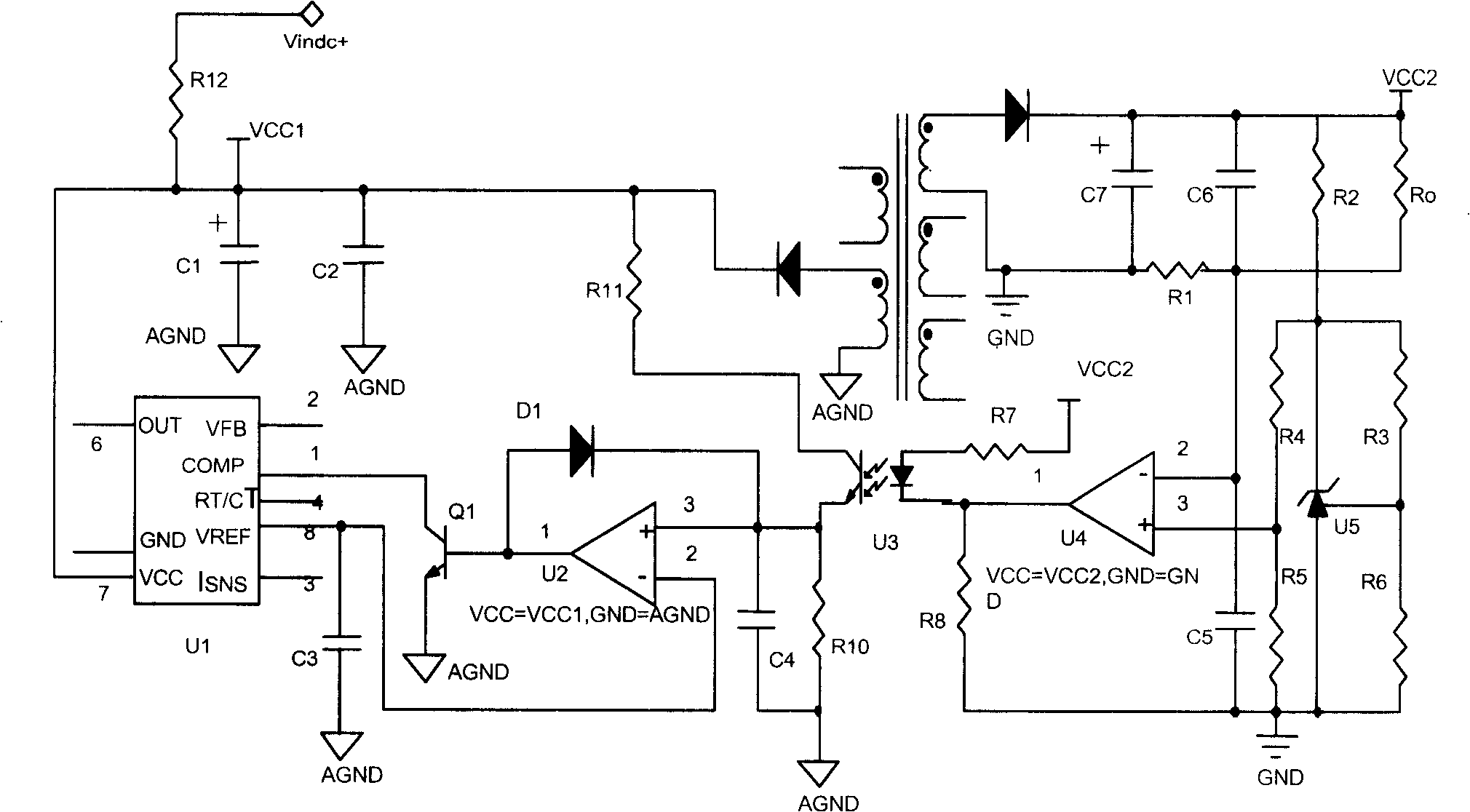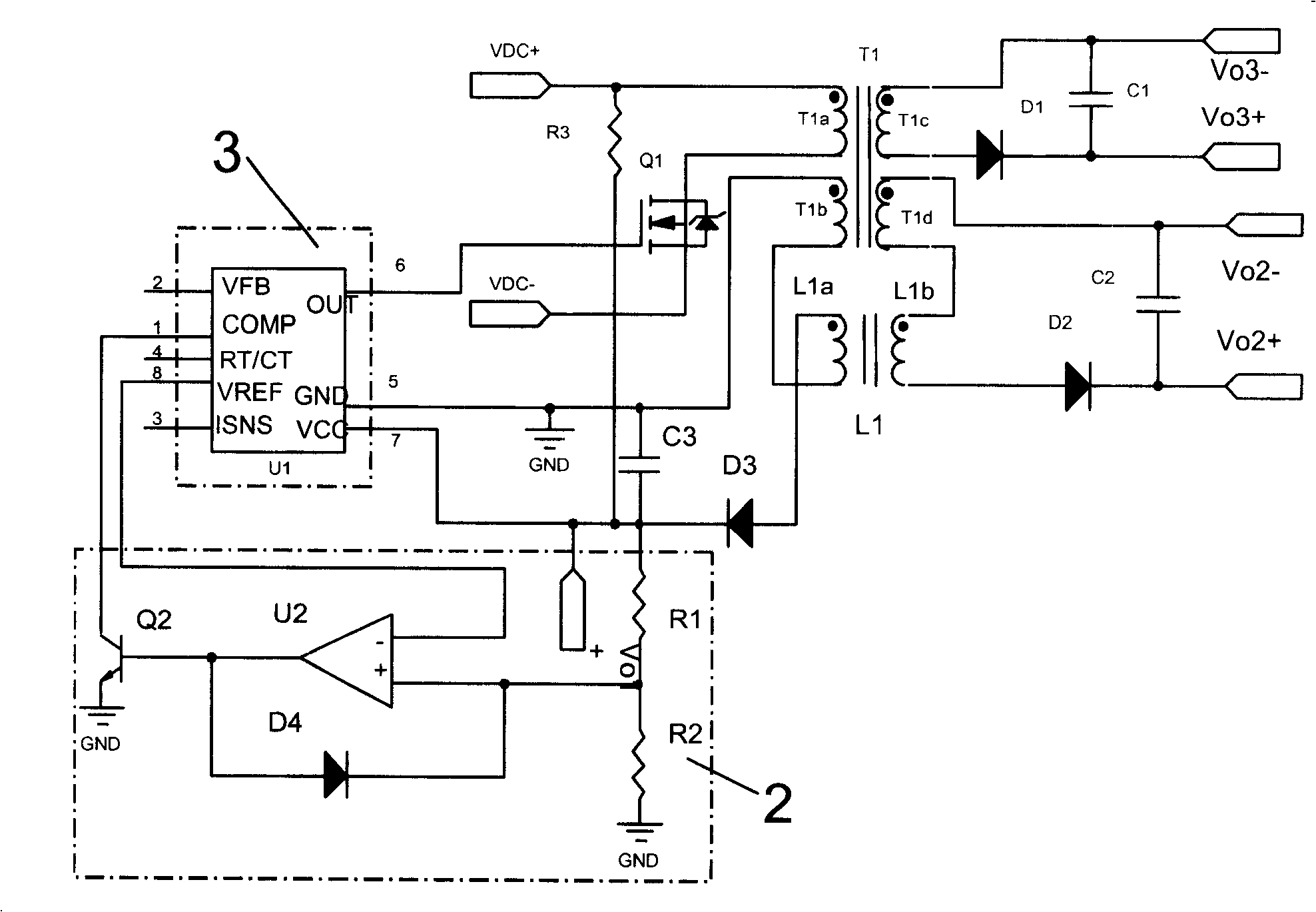Multiple output power supply
A multi-channel output, power supply technology, applied in the output power conversion device, the conversion of DC power input to DC power output, electrical components and other directions, can solve the problem of high temperature of the transformer, unable to pass the safety regulations, overheating of the wiring, and power supply duty cycle. It can improve the electromagnetic compatibility characteristics, prevent the temperature from being too high, and the circuit is simple.
- Summary
- Abstract
- Description
- Claims
- Application Information
AI Technical Summary
Problems solved by technology
Method used
Image
Examples
specific Embodiment approach 1
[0036] like figure 2 The shown single-ended flyback three-way output power supply includes a transformer T1 , a voltage detection and comparison module 2 , and a power control module 3 . The transformer T1 has four windings, namely the first primary winding T1a, the second primary winding T1b, the first secondary winding T1c and the second secondary winding T1d. Among them, the first primary winding T1a corresponds to the input of the transformer T1, the second primary winding T1b, the first secondary winding T1c and the second secondary winding T1d correspond to the three outputs of the transformer T1, namely Vo1, Vo2 and Vo3 Road. The Vo1 output is also connected to the voltage detection and comparison module 2 as an output overcurrent or short circuit detection circuit. The Vo2 output is a small current output, that is, its rated load current is small; the Vo3 is a main output with feedback (not shown in the figure).
[0037] The switch tube Q1 is connected between the ...
specific Embodiment approach 2
[0065] like Figure 7 As shown, the difference between this specific embodiment and the first specific embodiment is that: the inductor L1 has three windings, namely the first winding L1a, the second winding L1b and the third winding L1c. The first winding L1a is connected in series on the detection output path, and the second winding L1b and the third winding L1c are respectively connected in series on the small current output path (the main output path is not shown in the figure). The current flow direction of the second winding L1b and the third winding L1c is opposite to that of the first winding L1a.
[0066] This enables directional over-current or short-circuit protection of the two low-current outputs. Apparently, windings can also be added to more than two small current output circuits, and overcurrent or short circuit protection for more than two small current output circuits has been formed.
specific Embodiment approach 3
[0067] like Figure 8 As shown, the difference between this specific embodiment and the first specific embodiment is that: the inductor L1 has three windings, namely the first winding L1a, the second winding L1b and the third winding L1c. The first winding L1a is connected in series on the detection output path, and the second winding L1b and the third winding L1c are connected in series on the small current output path and the main output path respectively. The current flow direction of the second winding L1b and the third winding L1c is opposite to that of the first winding L1a.
[0068] Due to the negative feedback of the main circuit, when a winding of the inductor is added to the main circuit, the added inductance will cause the voltage of the main circuit to drop when the main circuit is overcurrent. Due to the closed-loop negative feedback, the duty cycle of the power supply will increase to maintain the main circuit The output of the detection circuit is stable, but t...
PUM
 Login to View More
Login to View More Abstract
Description
Claims
Application Information
 Login to View More
Login to View More - R&D
- Intellectual Property
- Life Sciences
- Materials
- Tech Scout
- Unparalleled Data Quality
- Higher Quality Content
- 60% Fewer Hallucinations
Browse by: Latest US Patents, China's latest patents, Technical Efficacy Thesaurus, Application Domain, Technology Topic, Popular Technical Reports.
© 2025 PatSnap. All rights reserved.Legal|Privacy policy|Modern Slavery Act Transparency Statement|Sitemap|About US| Contact US: help@patsnap.com



